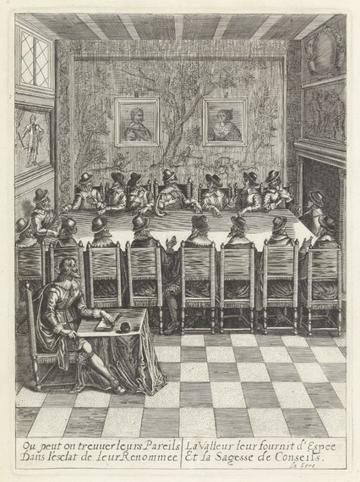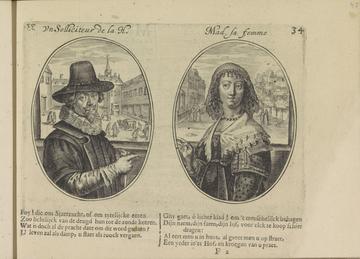Dealing with petitions in the English Parliament and the Dutch States General
Early modern European societies have been characterized as “petitionary societies”. These societies were undemocratic by any modern standards, but this does not necessarily mean that rulers were unresponsive to the desires or grievances of their subjects. While few people had the right to choose their own representatives, almost everybody participated in the practice of petitioning. A petition is essentially a written request to an authority, but petitionary practices varied from one context to another, and were subject to different rules and conventions. In most European languages, petitionary documents went by many names, which can be seen as an indication of their importance. Citizens petitioned individually and in groups, and they petitioned for everything from the redress of personal grievances to constitutional reform. Most political (and judicial) authorities received petitions, and much, if not most legislation that was drafted in early modern European societies was preceded by the reception of one or more petitions.
The prototypical petition, or supplication, was the petition to the monarch. Since time immemorial, kings and emperors had been supplicated by their subjects. Originally a supplication was a ritualistic combination of gestures and spoken words, but the written form, in which formulaic language replaced the ritual performance, was common already in antiquity. Suppliants in ancient times often had the choice between supplicating to a god or to a king. In the middle ages, under the influence of the doctrine of the divine right of kings, petitioning the monarch continued to be a practice not dissimilar to praying to God, as kings took their authority from God and ruled on God’s behalf. Whereas petitioning the monarch was to remain a common practice throughout Europe until modern times, other political institutions at all levels of government started to receive large numbers of petitions as well. At the central level of government, representative assemblies were no exception to this rule.

Presenting a petition to the English secretary of state, c. 1654. Print created by William Sherman, from: W. Stubbe, 'A Further Justification of the Present War against the United Netherlands', Londen, 1673. Rijksmuseum Amsterdam.
From the work of Gwilym Dodd and others, we know that in England, for instance, petitioning was a crucial practice already in the context of the late medieval parliament. Petitions began to be presented from the 1270s onwards, during the reign of Edward I. These petitions were presented in parliament, but they were presented to the king and council. Most petitioners petitioned for gifts or favours, or to obtain justice from the king. Such private petitions could be presented to the king and his council personally by individuals or groups, but more often petitioners commissioned their representative in Parliament to present it for them. From the 1370s and more commonly in the course of the fifteenth century, such petitions began to be addressed to the House of Commons rather than to the king directly. Besides private petitions, there were also common petitions, presented by the Commons to the King, on their own behalf or on the behalf of a group of subjects. We know relatively little about the petitions submitted to Parliament in the fifteenth and sixteenth centuries, but it seems clear that there has been a sharp rise in the numbers of petitions from the late sixteenth century onwards, culminating in the 1620s. In the early seventeenth century, petitioners presented so many petitions expressing grievances through the House of Commons, that new procedures had to be made to deal with them. The later seventeenth-century Parliament also received increasing numbers of petitions concerned with legislation, mostly coming from interest groups who sought new legislation, or tried to influence bills under consideration.
The lobby of the House of Commons was sometimes full of groups of people wanting to present petitions, especially during moments of crisis such as the 1640s. Though the House of Commons formally and routinely prevented public access to their debates, it was in practice always easy to get close to the chamber to present petitions or talk to members. Finally, in 1661, it was made illegal to present petitions with more than ten persons. In the seventeenth century most petitions seem to have been presented by individual MPs who acted as intermediaries, as would become the standard practice in the eighteenth century. There are also examples of groups of petitioners, representing for example a local community, who were allowed in the House to present their petitions in person. This, too, may have ended after 1661, although more research on this point is necessary.

Assembly of the Dutch States General, print maker unknown. From: Jean Puget de la Serre, Histoire de l'entree de la reyne mere du Roy tres-chrestien, dans les Provinces Unies des Pays-Bas, London, 1639. Rijksmuseum Amsterdam.
How does this compare to the situation in the Dutch Republic, a close neighbour to England, and one that had a strong tradition of political assemblies as well? Whereas in England, original petitions to Parliament in the early modern period got destroyed in the nineteenth century, the Dutch National Archives hold a large collection of original petitions to the representative central state institution of the States General. By far most of the extant petitions date from after around 1680, when it seems that petitions started to be systematically archived. For the earlier Dutch Republic the collection is much more fragmentary, and it does not at all contain petitions from the sixteenth century. As of yet the petitions to the Dutch States General have never systematically been studied; any such study would have to start with the resolutions of the States General. In a project that is currently being executed at the Huygens Institute for Dutch History, we aim to provide digital access to all resolutions of the States-General issued between 1576, the year when the States General first convened on their own initiative (rather than on that of their overlord) and 1796, the year when they were disbanded. By the end of this project, it will be possible, for this entire period, to narrow down a search query to only those resolutions that discuss petitions; currently this feature is available already for most of the eighteenth-century resolutions. Moreover, it should become possible to search within resolutions following petitions and select only resolutions issued in response to petitions submitted by petitioners self-identifying as, for instance, merchants from Amsterdam, widows, or ambassadors.
For the moment, thanks to the work of Joke Roelevink, Theo Thomassen and others, we are better informed about the procedures regarding petitions to the States General than about their contents. Petitions could not, like in England, be submitted by members of parliament, if only because the States General did not have members who represented constituencies, but delegates who represented provincial estates assemblies. Instead, they would have to be presented to the chairman of the assembly, but in practice, it also happened that they were given to one of the clerks. The chairman decided, together with the chief clerk, when and how petitions were to be dealt with by the States General. The standing orders of 1577 give the chairman the right to create committees that were to prepare concept-resolutions in response to petitions, among other documents. As petitionary activity seems to have increased, the States General attempted to regulate it further. From the mid-seventeenth century, it was made obligatory for petitions to be submitted through intermediaries, which were known as solliciteurs or procureurs. These agents, who received an accreditation from the States General, represented the interests of lower governments bodies, corporations such as guilds and churches, or individual inhabitants of the Dutch Republic. Some of these agents were permanently on the payroll of clients they represented, but they also worked on an ad hoc basis.

Solliciteur from The Hague, with his wife. In the background behind the solliciteur, one can see the Binnenhof. From: Crispijn van de Passe, Les abus du mariage, Amsterdam, 1641.
When compared to the petitionary activity taking place at the English Parliament, the petitionary practice surrounding the seventeenth-century States General seems to have been more contained: there does not appear to have been a habit of groups of petitioners collectively entering the buildings of the Binnenhof (the 'Inner Court') to try and present their petitions, nor did the States General generally receive petitions with many signatures. This was partly due to the political system of the Dutch Republic: political decision-making was a bottom-up process, and in order to have an impact on decisions taken at the central state level, lobbying by petitioning would often have to start at the level of the various urban governments and colleges of nobles with a vote in the provincial estates assemblies. The States General ruled directly over those territories that were within the Dutch Republic but outside the seven provinces (the so-called “generality lands”), and they were responsible for the foreign policy of the united provinces, so much of the petitionary activity had to do with their jurisdiction in these matters. The intermediaries involved in the petitionary practice could be held responsible for the contents of the petitions and thus acted as gatekeepers, which helps to explain why, until the start of the age of revolutions in the late eighteenth century, petitions to the Dutch States General rarely seem to have been of a transgressive nature.
The English Parliament and the Dutch States General are of course only two examples of representative institutions that received (great numbers of) petitions. For both of these institutions, as for others, dealing with petitions was a vital task that took up a lot of their time. Understanding how early modern parliamentary cultures dealt with petitions is crucial because it can tell us much about how parliamentary institutions saw themselves in relation to the people they represented and – in monarchical states – the sovereign. I am confident that our Recovering Europe’s Parliamentary Culture, 1500-1700 project, with its rigorously comparative approach, can play an important role in demonstrating how petitioning was a practice that connected representative institutions across Europe, while at the same time bringing to the fore the particularities of these institutions.
Joris Oddens, Head of Political Culture and History at Huygens ING (KNAW).
*I would like to thank Paul Seaward for allowing me to draw on his knowledge of the English case.


